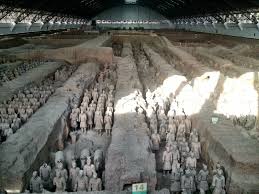
The Discovery of the Terracotta Army: A Testament to Ancient Chinese Power
A Chance Discovery
The story of the Terracotta Army's discovery begins not with archaeologists, but with farmers digging a well in Lintong District, Shaanxi province, China. On March 29, 1974, their tools struck something hard and unyielding. Unearthing their find, they were met with the fragmented remains of a life-size terracotta warrior, its intricate armor and weaponry hinting at a forgotten past.
Unveiling an Army
News of the discovery spread like wildfire, quickly reaching the ears of archaeologists who immediately recognized its significance. The farmers had stumbled upon the easternmost pit of the Terracotta Army complex, an elaborate mausoleum built to accompany China's first emperor, Qin Shi Huang, into the afterlife.
Excavations began in earnest, revealing row upon row of meticulously crafted terracotta soldiers, each with unique facial features, hairstyles, and postures. This army, numbering over 8,000 strong, was accompanied by horses, chariots, and weapons, all crafted with astonishing realism and attention to detail.
A Glimpse into the Past
The Terracotta Army provides an invaluable window into the military might and cultural practices of the Qin dynasty. The sheer scale of the project, the advanced craftsmanship, and the meticulous arrangement of the figures speak volumes about the emperor's power and the advanced state of Chinese civilization at the time.
The discovery of the Terracotta Army was not just about finding ancient statues; it was about uncovering a lost chapter in human history. This silent army, standing guard for over two millennia, continues to captivate the world with its grandeur and historical significance.
FAQs
Q1: What is the significance of the Terracotta Army?
The Terracotta Army is significant for several reasons:
- Historical Significance: It provides invaluable insights into the military organization, weaponry, and cultural practices of the Qin dynasty.
- Artistic Significance: The craftsmanship and detail of the figures are a testament to the skill of ancient Chinese artisans.
- Cultural Significance: The army is a powerful symbol of Chinese history and culture, attracting millions of visitors each year.
Q2: How many warriors were discovered at the time of discovery?
While the entire complex is believed to contain over 8,000 figures, the initial discovery by the farmers in 1974 only unearthed a handful of warriors. It was through subsequent excavations that the true scale of the army was revealed.
Q3: Are all the warriors identical?
No, each warrior is unique, with distinct facial features, hairstyles, and postures. This individuality adds to the realism and artistry of the army.